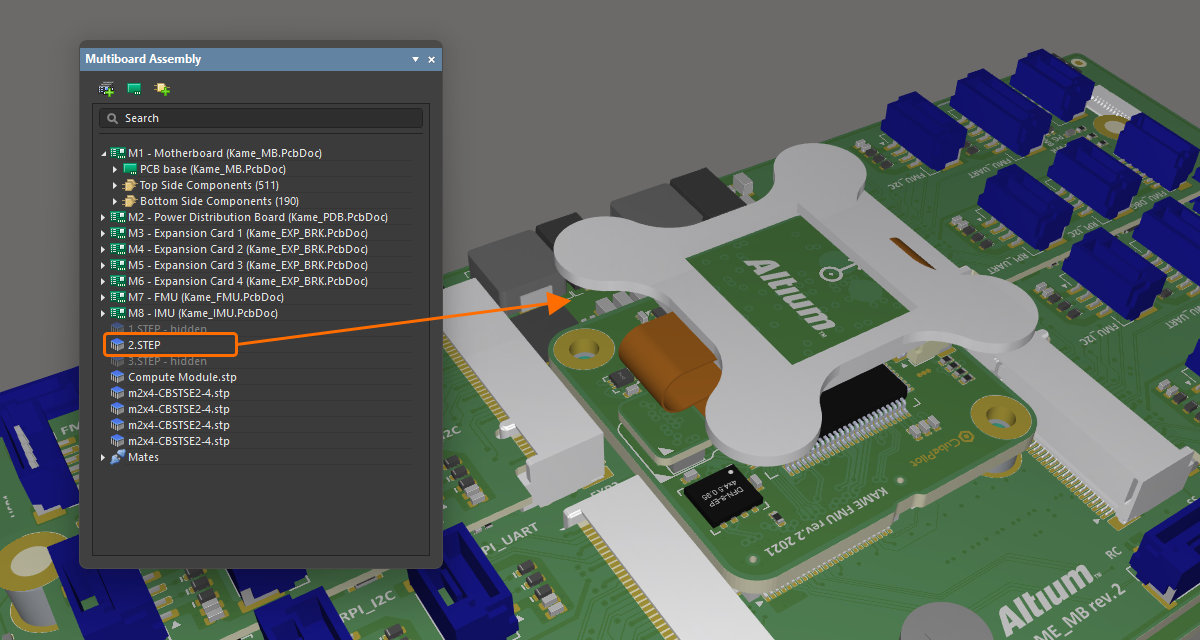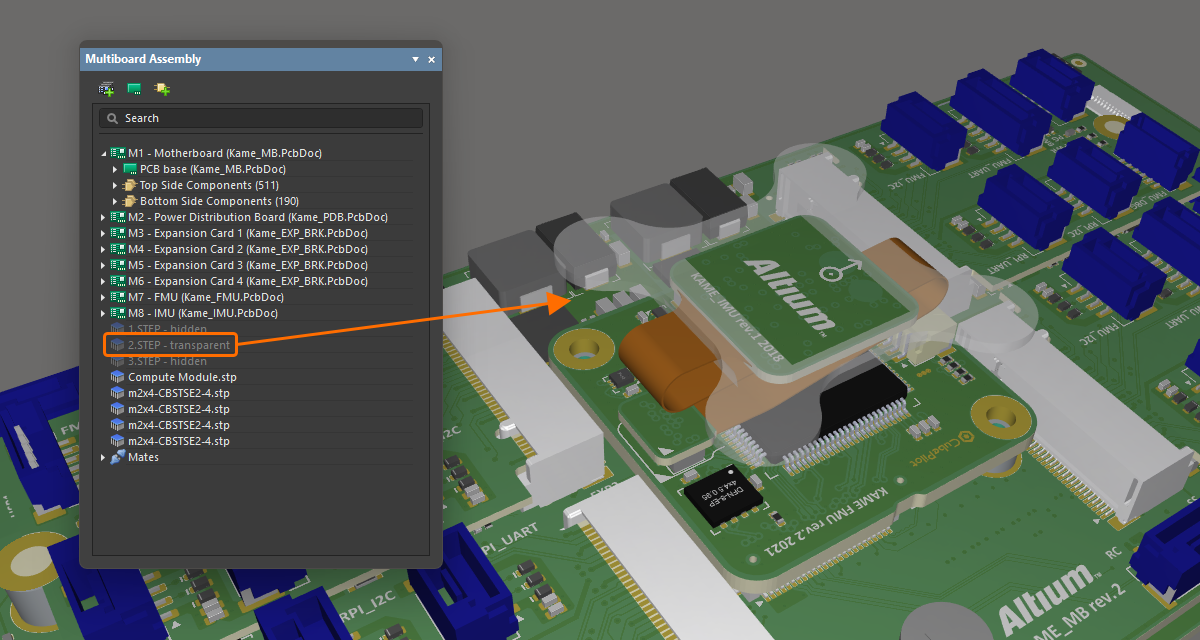Creating the Physical Multi-board Assembly in Altium Designer
Altium Designer는 멀티 보드 어셈블리 생성을 지원합니다 *.MbsDoc*.MbaDoc
멀티 보드 어셈블리의 논리 설계 단계에 대해 자세히 알아보려면, 논리 시스템 설계 캡처 페이지를 참조하세요.
새 멀티보드 어셈블리 문서를 만들려면 다음과 같이 하세요:
-
오른쪽 버튼으로 멀티보드 프로젝트에 새 멀티보드 어셈블리 문서(
*.MbaDocProjects 패널에서 프로젝트 항목을 마우스 오른쪽 버튼으로 클릭,Add New to Project » Multi-board Assembly 을 선택합니다. -
새 멀티 보드 어셈블리 문서를 저장합니다(해당 항목을 마우스 오른쪽 버튼으로 클릭하고
Projects 패널에서 항목을 마우스 오른쪽 버튼으로 클릭하고Save As 을 선택합니다(상황에 맞는 메뉴에서). -
시스템의 논리적 표현을 멀티보드 회로도에서 멀티보드 어셈블리 문서로 전송합니다 - 자세히 알아보기.
-
기구 인클로저를 사용할 수 있는 경우, 어셈블리에 로드 - 자세히 알아보기.
-
어셈블리 내에서 각 요소를 배치합니다 - 자세히 알아보려면 보드 배치 및 방향 설정 페이지를 참조하세요.
-
mates를 사용하여 어셈블리 내의 요소를 연결 - 자세한 내용은 mates로 작업하기 페이지를 참조하세요.

멀티 보드 어셈블리 예시. 여러 개의 연결된 PCB가 기구 인클로저 내에 배치됩니다.
시스템 디자인을 멀티보드 어셈블리 문서로 전송하기
다음 명령 중 하나를 사용하여 멀티보드 설계를 멀티보드 회로도에서 멀티보드 어셈블리 문서로 전송할 수 있습니다:
-
멀티 보드 회로도 편집기의 주 메뉴에서 Design » Update Assembly -
.MbaDoc . -
멀티보드 어셈블리 편집기의 주 메뉴에서 Design » Import Changes From
.PrjMbd .
이러한 명령 중 하나를 실행하면 소프트웨어가 멀티 보드 회로도의 각 모듈을 조사하고 각 하위 프로젝트에 대해 선택된 PCB/어셈블리를 식별한 다음 해당 보드를 어셈블리에 추가하는 데 필요한 수정 목록을

각 PCB 프로젝트의 기판은 ECO 수정 사항으로 나열되며 ECO가 실행될 때 다중 기판 어셈블리 편집기에 로드됩니다.
![]() 버튼을 클릭하면 보드/어셈블리가 멀티보드 어셈블리 에디터에 로드됩니다. 각 보드/어셈블리는 하위 프로젝트에 있는 것과 동일한 방향으로 디자인 공간에 배치됩니다. 각 PCB의 전체 데이터 세트를 분석하고 로드해야 하므로 이 프로세스에는 다소 시간이 걸립니다.
버튼을 클릭하면 보드/어셈블리가 멀티보드 어셈블리 에디터에 로드됩니다. 각 보드/어셈블리는 하위 프로젝트에 있는 것과 동일한 방향으로 디자인 공간에 배치됩니다. 각 PCB의 전체 데이터 세트를 분석하고 로드해야 하므로 이 프로세스에는 다소 시간이 걸립니다.

멀티 보드 어셈블리의 보드를 멀티 보드 어셈블리 편집기 디자인 공간에 로드하여 위치를 지정할 준비가 되었습니다.
멀티 보드 어셈블리에 추가 오브젝트 추가하기
멀티 보드 어셈블리(멀티 보드 회로도에 참조된 PCB뿐만 아니라)에 추가 개체를 로드할 수도 있습니다. 추가 오브젝트는

적절한 명령 또는 버튼을 사용합니다:
-
Insert PCB Part - 이 어셈블리에 다른 PCB를 삽입합니다. -
Insert MBA Part - 이 어셈블리에 다른 멀티 보드 어셈블리를 삽입합니다. -
Insert STEP Part - 이 어셈블리에 STEP 형식의 기계 모델을 삽입합니다.
어셈블리 부품 업데이트 또는 편집
파트 잠금/잠금 해제
파트를 잠그거나 잠금 해제하려면 원하는 파트를 선택하고 마우스 오른쪽 버튼을 클릭한 다음,
-
잠긴 파트는 편집/이동할 수 없습니다.
-
잠긴 파트는 자물쇠 아이콘으로 표시되며
Multiboard Assembly 패널에 자물쇠 아이콘이 표시됩니다. -
잠긴 개별 파트에는 개체 기즈모가 표시되지 않습니다(개체 기즈모에 대해 자세히 알아보려면 보드 위치 지정 및 방향 설정 페이지를 참조하세요).
-
잠긴 파트는 소스(움직이는 객체 - 파트 결합에 대해 자세히 알아보려면 메이트 작업 페이지 참조)로 선택된 경우 결합할 수 없습니다.
파트 업데이트
어셈블리에 추가된 파트 또는 3D 바디가 업데이트된 경우 다음 작업 중 하나를 사용하여 업데이트를 멀티보드 어셈블리에 로드할 수 있습니다:
-
메인 메뉴에서
Edit » Update All Parts 명령을 선택하거나 디자인 공간의 아무 곳이나 마우스 오른쪽 버튼으로 클릭하고 컨텍스트 메뉴에서Update All Parts 명령을 선택하거나 컨텍스트 메뉴(바로 가기:Shift+Ctrl+U -
필요한 부품을 선택하고 메인 메뉴 또는 오른쪽에서
Edit » Update Selected Part 명령을 선택하거나 디자인 공간의 아무 곳이나 마우스 오른쪽 버튼으로 클릭하고 컨텍스트 메뉴(바로 가기)에서Update Selected Part 명령(바로 가기(Ctrl+U -
필요한 3D 바디를 선택하고 메인 메뉴 또는 오른쪽 메뉴에서
Edit » Update Selected 3D Body 명령을 선택하거나 디자인 공간의 아무 곳이나 마우스 오른쪽 버튼으로 클릭하고 컨텍스트 메뉴에서Update Selected 3D Body 명령을 선택하면 활성 멀티 보드 어셈블리에서 선택한 3D 바디를 해당 하위 PCB 문서의 최신 레이아웃 정보로 업데이트할 수 있습니다.
부품 편집하기
멀티 보드 어셈블리 편집기 내에서 어셈블리 또는 PCB 편집 세션을 시작할 수 있습니다. 필요한 부품을 선택하고 Ctrl+E
필요에 따라 수동 배치 및/또는 정렬 기능을 사용하여 컴포넌트의 배치를 변경합니다. 편집이 끝나면 Ctrl+E
변경 사항을 구현하지 않고 편집을 취소하려면
멀티 보드 어셈블리 탐색 및 관리하기
멀티 보드 어셈블리를 탐색하고 관리하려면

패널에는 전체 어셈블리 구조의 확장 가능한 트리 보기가 표시됩니다:
-
포함된 기판(PCB) 및 멀티 보드 어셈블리, 각 PCB 내의 컴포넌트, 레이어 및 네트
-
포함된 STEP 모델
-
포함된 기타 멀티 보드 어셈블리
-
어셈블리의 객체 간에 형성된 메이트
멀티 보드 어셈블리의 요소 강조 표시하기
Shift+ClickCtrl+Click

디자인 공간에서 선택한 세 개의 보드도 패널에서 강조 표시됩니다.
어셈블리 부품의 가시성 및 투명도 제어하기
패널은 특정 부품을 강조 표시할 뿐만 아니라 현재 패널에서 선택된 부품의 가시성과 투명도를 제어하는 데에도 사용할 수 있습니다. 선택한 부품을 마우스 오른쪽 버튼으로 클릭한 다음
|
STEP 모델이 어셈블리에서 완전히 표시됩니다. 동일한 모델을 투명하게 만들었습니다. 동일한 모델이 완전히 숨겨졌습니다. |
거리 측정하기
메인 메뉴의 Ctrl+M
-
첫 번째 3D 객체 또는 해당 객체의 특정 면을 선택합니다. 잠재적인 3D 물체 위로 커서를 이동하면 해당 물체의 색상이 변경됩니다. 개체의 특정 면을 선택하려면 커서를 이동하면서
Ctrl -
두 번째 3D 개체 또는 해당 개체의 특정 얼굴을 선택합니다.
-
이 도구는 선택한 두 개체(면) 사이의 최단 거리를 시각적으로 표시합니다.
-
다른 물체/면 사이의 거리 측정을 계속하거나
Esc
충돌 테스트
충돌은 두 오브젝트에 닿거나 교차하는 표면이 있을 때마다 플래그가 지정됩니다.
충돌을 확인하려면 Ctrl+K
모든 충돌은 패널을 통해 보고되며
필요한 경우 충돌 검사를 실행한 후 디자인 공간에서 강조 표시된 충돌 위반은
리지드 플렉스 지원
멀티 보드 어셈블리 에디터는 리지드 플렉스 PCB를 지원합니다. 리지드 플렉스는 연성 회로와 리지드 회로의 조합인 인쇄 회로에 부여된 이름입니다. 멀티 보드 어셈블리 편집기는 PCB 편집기에서 정의한 대로 최종 접힌 상태로 PCB를 표시합니다.

리지드-플렉스 PCB 설계에 대한 자세한 내용은 리지드-플렉스 PCB 설계 페이지를 참조하십시오.
MCAD로 내보내기
어셈블리는 STEP 3D 또는 Parasolid 형식으로 내보낼 수 있습니다. 전체 어셈블리를 STEP 3D로 내보내려면(*.step*.stp*.x_t

MCAD 도구에서 열린 멀티 보드 어셈블리의 STEP 파일 예시.
PDF 3D로 내보내기
멀티 보드 어셈블리 문서를 PDF 파일로 내보낼 수도 있습니다(*.pdf

자세한 내용은 PDF3D 파일 준비하기 페이지를 참조하세요.





 AI로 번역됨
AI로 번역됨